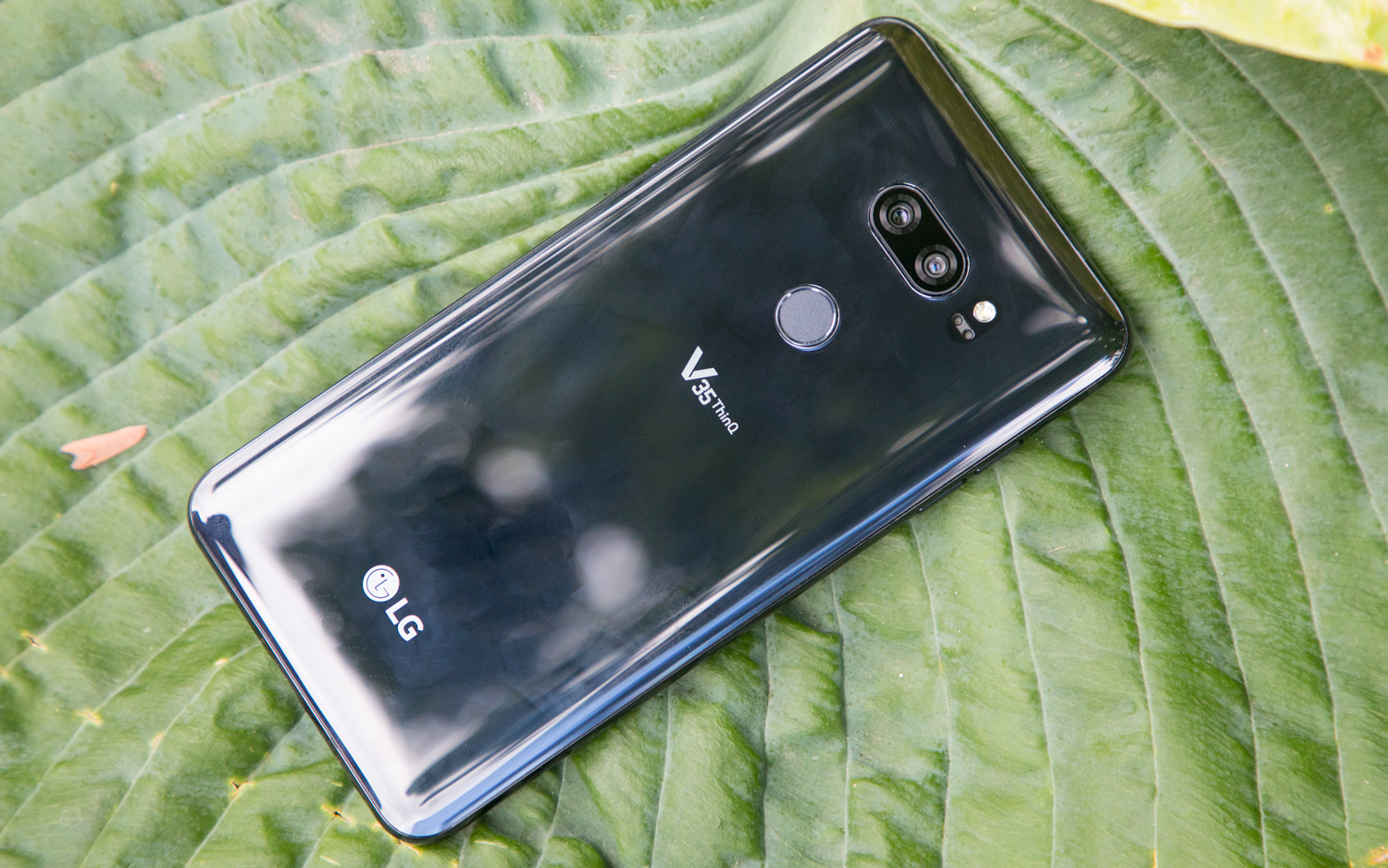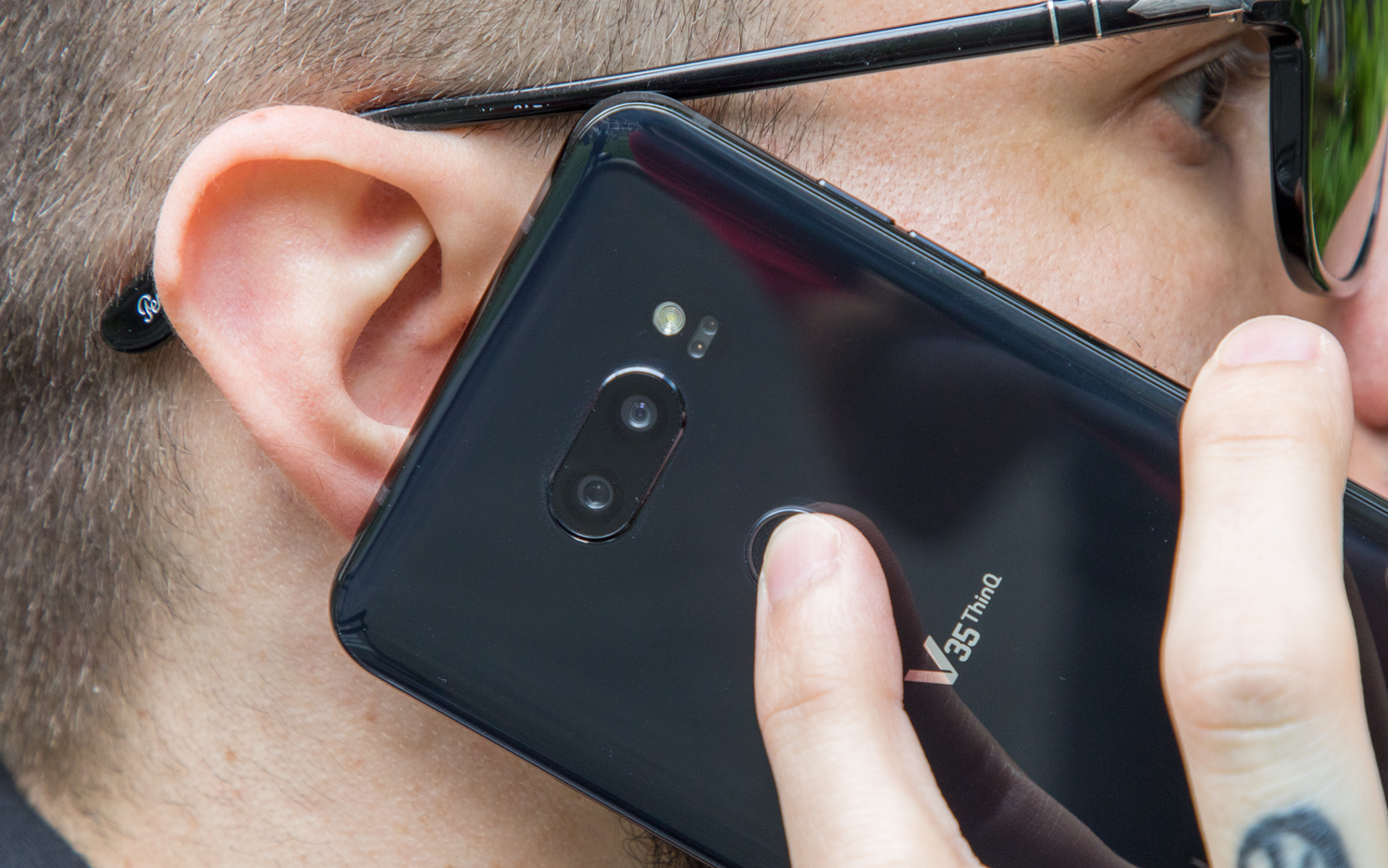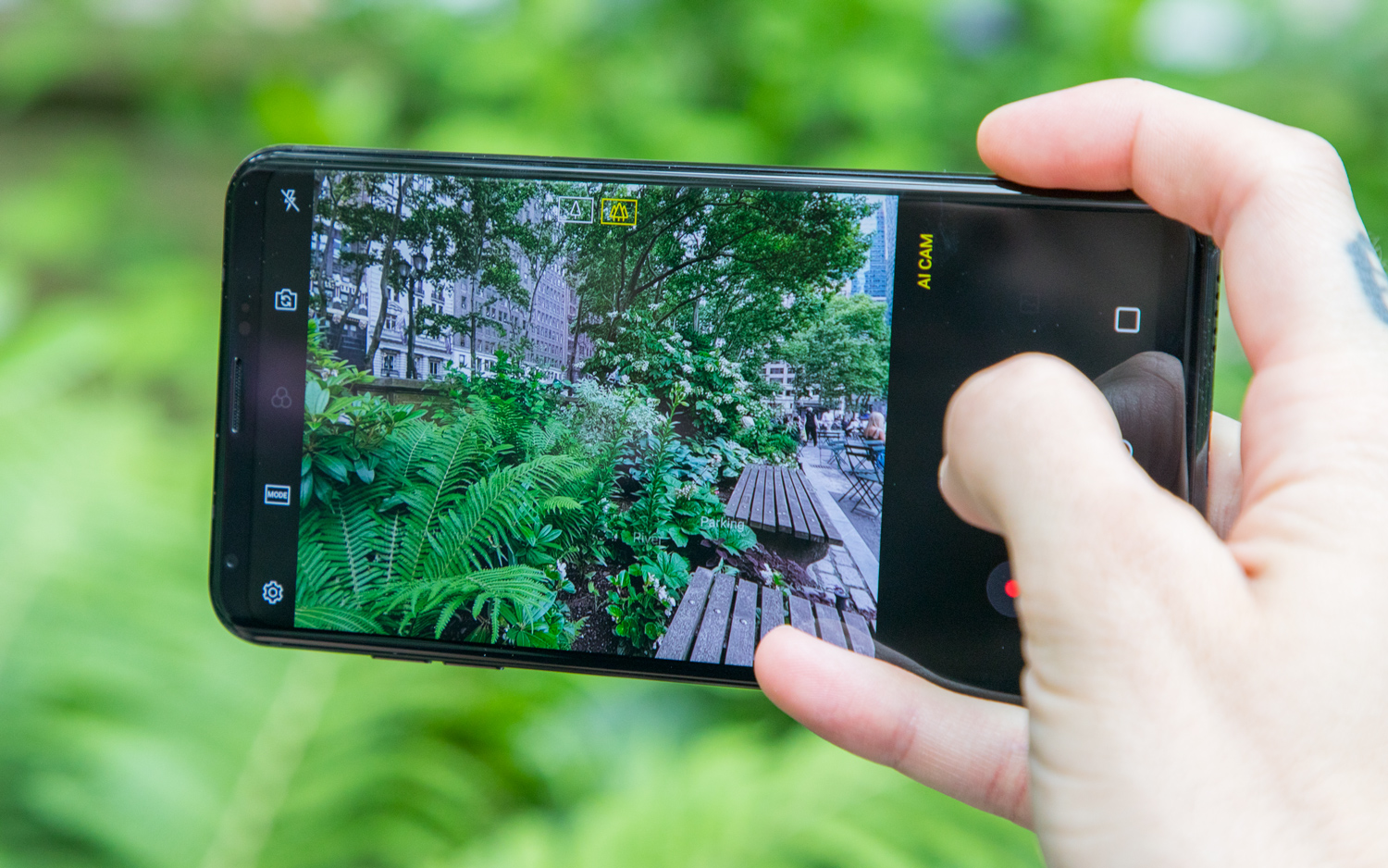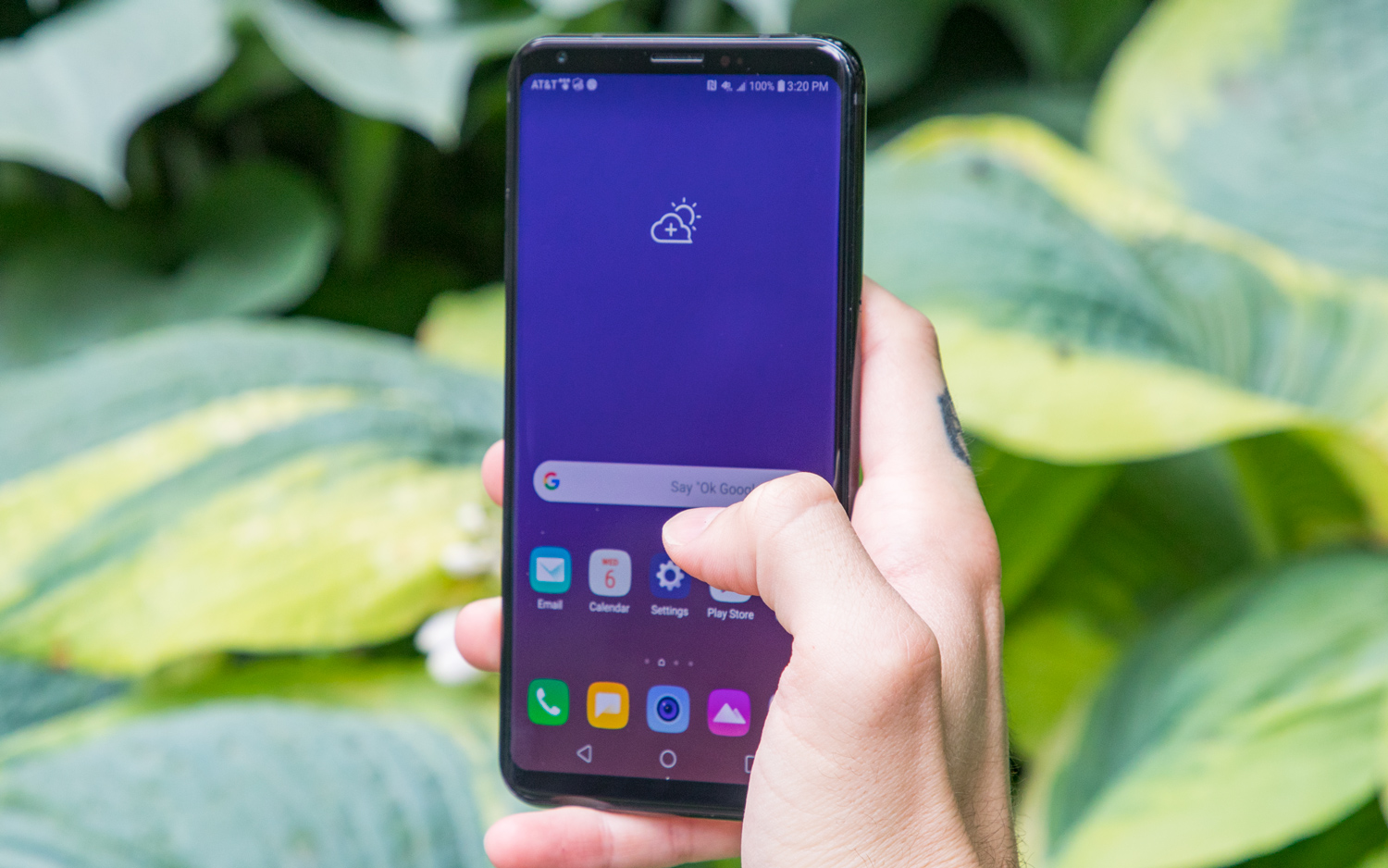Tom's Guide Verdict
LG has remixed the remix of its fall flagship. But are beefier specs enough to earn the company's latest V-series offering another look?
Pros
- +
Lightweight, minimalist design
- +
Good OLED screen
- +
Great performance
Cons
- -
Subpar battery life
- -
Limited storage
- -
Disappointing AI cameras
- -
Expensive
- -
Limited to two carriers
Why you can trust Tom's Guide
Editors' Note: We've updated this review to note LG's release of the V40 ThinQ, the new entry to its V-series of phones that features three rear cameras plus two more shooters on the front.
If at first you don't succeed, repeatedly rerelease your phone until somebody notices. This appears to be LG's strategy with the V30, the flagship phone the company introduced in October 2017.
A few months later, LG launched an iteration of the V30 called the V30S ThinQ that was almost exactly the same but with more storage and a camera powered by AI object recognition. Since that camera update also made it to the V30, the V30S ThinQ felt especially pointless.
Now, there's yet another revision of the V30: the V35 ThinQ. To LG's credit, this third attempt is at least appreciably different under the hood, and the V30 was already a competent phone. But with this device's steep price of $899 and exclusivity to AT&T and Google Project Fi, LG sure is asking customers to make a lot of sacrifices for last year's design — especially with the subsequent release of the LG V40 ThinQ and its unique five-camera setup..
What's new
On the surface, the V35 ThinQ looks and feels like the V30 and V30S that came before it. The biggest changes can't been seen from the exterior, though they are pretty sizable upgrades over LG's earlier models.

For starters, LG has upgraded the system-on-chip to Qualcomm's latest Snapdragon 845 platform. This is the same processor powering the LG G7 ThinQ, as well as countless other topline Android handsets that have debuted in 2018 (including LG's own V40).
MORE: Best Cheap Unlocked Smartphones
However, LG didn't stop there. The company gave the V35 6GB of RAM, up from 4GB in all of LG's recent flagships, including the G7. That makes the V35 the most powerful of all of LG's phones, even though this device is also unavailable on most carriers and not sold unlocked.

LG redesigned the cameras for the new phone, too. The V35 inherits the G7's imaging tech, meaning users get a pair of 16-megapixel sensors on the back of the handset. The main camera has an f/1.6 aperture — among the largest in modern phones — as well as optical image stabilization. The secondary lens is rated f/1.9 and employs a 107-degree, wide-angle perspective. The front camera also produces slightly sharper selfies, now 8 megapixels, up from the V30's 5 megapixels.
LG V35 ThinQ Specs
| Price | $899 |
| OS | Android 8.1 Oreo |
| Screen Size (Resolution) | 6-inch LCD (2880 x 1440) |
| CPU | Qualcomm Snapdragon 845 |
| RAM | 6GB |
| Storage | 64GB |
| microSD Slot | Yes |
| Rear Camera | Dual: 16 MP (f/1.6) with OIS; 16 MP (f/1.9) |
| Front Camera | 8 MP, f/1.9 |
| Battery Size | 3,300 mAh |
| Battery Life (Hrs:Min) | 9:11 |
| Water Resistance | Yes, IP68 |
| Size | 5.97 x 2.97 x 0.29 inches |
| Weight | 5.54 ounces |
How is the V35 different from the G7?
Even though the processor and cameras are identical, a lot is different between the two phones, actually. LG says its V-series phones are where it prefers to experiment with features aimed at early adopters and the hard-core crowd. This series is where LG began implementing quad digital-to-analog converters for better audio playback — something that just made its way into the G7.

But not all of those benefits have trickled down to LG's more mainstream flagship. The V35's 6-inch pOLED screen is probably the best example of that. V35 owners also get the aforementioned extra RAM compared to what the G7 has, and of course, the two phones' designs are totally different. If you hate notches, you'll likely find the V35 to be a much more attractive phone.

Interacting with this phone is fundamentally different, too. The G7 has a taller, 19.5:9 aspect ratio, which makes this handset thinner and a bit easier to use one-handed than the V35, with its 18:9 aspect ratio. The V35 also statshes its power button in the fingerprint sensor on the back, below the camera. This design is an odd holdover from LG's older devices, considering the G7 has a stand-alone power button on the right edge and a Google Assistant key on the left. Thankfully, though, you can still double knock on the V35's screen, so you won't have to lift the phone every time you need to wake it.
What we like about the V35
It may not feel quite as remarkable so many months later, but there's still something to be said for the V35's design. Even beyond the lack of a notch, LG settled upon a really minimalist and understated look with the V30 series that many phones approach but don't nail down.

The V35's dimensions haven't changed at all, but the top and bottom bezels are still thinner than what you find on most modern flagships. That makes a difference, as do the rounded metallic edges, the lack of a sizable camera hump on the back and the V35's extreme lightness, at 5.54 ounces.
In fact, the V35 is actually a hair lighter than the G7 and more than half an ounce lighter than the iPhone X. That might not seem like a big deal, but you feel the difference from the moment you pick up the phone. And the lighter weight contributes to the overriding sensation of simplicity inherent in the V35, something that escapes most of its competitors.
The V35's specs place it within the upper echelon of Android handsets.
The design cedes center stage to the V35's edge-to-edge pOLED (plastic OLED) screen. LG's OLED display tech still isn't quite up to Samsung's par; the V35 has a peak full-screen brightness of 467 nits, which pales in comparison to the Galaxy S9+ and its 630 nits. There's also a slight grain effect on the V35 when you look really closely at solid colors, an effect that is imperceptible on the Galaxy duo.
However, I'd much rather take the V35's display over the G7's LCD panel, which is incapable of offering comparably intense hues or perfect-pitch blacks. And any fears related to the Pixel 2 XL's LG-sourced pOLED screen are thankfully unfounded. The V35's display appears better calibrated to my eye and allows users to choose from among four profiles, ranging from muted to ultrasaturated, so everyone can customize the screen to their preference.
MORE: Best Smartphones on the Market Now
In terms of performance, the V35's internals place it within the upper echelon of Android handsets. LG's latest flagship scored 9,027 in Geekbench 4, coming very close to the 8GB OnePlus 6's score of 9,098.
However, the V35 strangely wasn't as adept at pushing polygons, as its 4,139 result in 3D Mark's OpenGL ES 3.1 benchmark was notably off the OnePlus 6's score of 5,124. Fortunately, this deficit wasn't reflected in gaming. The V35 navigated PUBG Mobile with ease, even on the game's more-demanding graphics settings.

If you have a proper set of headphones, you'll also appreciate the V35's quad digital-to-analog converter, which adds rich, atmospheric texture to any audio played back through the phone's 3.5-millimeter port. The G7 featured the same technology, and we're glad to see it become a staple of LG's premium line.
What we don't like about the V35
The V35 is far from a perfect phone. But even if it were flawless, at $899 and tied to just two carriers, the price is exceptionally hard to justify.
If it's the performance you like most, look to the OnePlus 6, which features the same processor and RAM combination but sells for $370 less — and is unlocked. If it's the OLED screen, check out the $719 Galaxy S9, whose panel is more impressive. The V35's other notable selling points, like its IP68 water resistance and microSD slot, appear in countless other Android phones.

And then there's the issue of storage; the V35 has only 64GB of it, and the system uses up roughly 13GB of that before you even take the phone out of the box. That's quite a small amount of storage for a device that starts at $899, and it'll only get smaller with successive updates.
This isn't the first phone to use AI to pump up photos — though it is one of the worst.
Although the V35 runs Android Oreo out of the box, this is not quite the latest revision of the OS. Like the G7, the V35 ships with Android 8.0, rather than 8.1. It's a small distinction, but nevertheless a frustrating one, given the price of the phone. And it's hard to imagine that those updates are going to come fast and frequently for this AT&T-exclusive model.
As for the cameras, the V35's new setup still left something to be desired compared to our top phone for photography, the Pixel 2 XL. The "ThinQ" part of the name refers to LG's AI-assisted smart technologies, and in this case, the V35 uses machine learning to enhance photos via scene and object recognition.
Of course, the V35 isn't the first phone to do this — though, in my experience, it is one of the worst. LG's AI enhancements tend to override natural scenes with boatloads of artificial processing and boosted colors, as happened in this oddly yellow selfie taken with the Portrait filter auto-applied.
A similar phenomenon occurred when I turned the V35's dual cameras on a friend at Brooklyn's Pier 6. The V35's white balance seems a bit off here, and details within the focal point seem overly soft as well. Despite a nice bokeh applied to the background, the sky is overexposed in LG's effort — a problem the Pixel avoids.
When I homed in on everything behind my friend, though, the V35 delivered a shot that was certainly brighter than the Pixel's but noticeably more washed out as a consequence. The f/1.6 aperture of the V35's main lens definitely works to the handset's advantage in darker scenes, but this is a double-edged sword. Sometimes, the V35's camera kills the contrast you do want, glossing over the shadows that add depth, life and drama to a photo. As a result, the Pixel can achieves a gorgeous sunset, while the V35 criminally blows out the same shot.

However, the V35 will provide a wide-angle perspective that most phones (outside of LG's own) won't offer, so at least there's that.
Finally, although LG has made strides with battery life in the G7 and now the V35, the company's devices still pale in comparison to those of its rivals in longevity. The V35 lasted 9 hours and 11 minutes on a charge in our battery test, in which the phone streamed web pages endlessly on AT&T's LTE network.
MORE: Smartphones with the Longest Battery Life
That result was somewhat surprising, as the V35 has the same 3,300-mAh battery as the V30 and the latter phone couldn't even break 6 and a half hours. As happy as we are to see LG make strides in efficiency, the V35 still lasted several hours less than many of its competitors, including the iPhone X (10:49), Galaxy S9+ (10:59) and Pixel 2 XL (12:09).
Bottom Line
As an upgrade to LG's "other" flagship, the V35 is a serviceable smartphone. It is as powerful as its contemporaries, has a solid OLED display, and maintains a featherweight edge-to-edge design that doesn't feel as overengineered as your typical premium handset nowadays — and that includes the LG G7 ThinQ.
However, the V35 is also something nobody asked for, and it brings nothing novel to the market. Say what you like about the G7's derivative looks, but at least it's a new expression for LG. The V35, however, is a rehash of a phone that came out last year, and LG has since released an even more advanced version in the V40. Many of the reasons you might've bought a V30 last fall — whether it was the improved audio or the wide-angle perspective — are popping up in other, cheaper phones that don't require you to be an AT&T or a Project Fi customer while parting with $899. The V35 is just fine, but for the sacrifices you'll have to make, just fine isn't good enough.
Credit: Tom's Guide
Adam Ismail is a staff writer at Jalopnik and previously worked on Tom's Guide covering smartphones, car tech and gaming. His love for all things mobile began with the original Motorola Droid; since then he’s owned a variety of Android and iOS-powered handsets, refusing to stay loyal to one platform. His work has also appeared on Digital Trends and GTPlanet. When he’s not fiddling with the latest devices, he’s at an indie pop show, recording a podcast or playing Sega Dreamcast.
-
allenfrx You can always bring an extra battery for your LGV35, 128G micro sd cards are cheap and even 256G cards are only about $80 bucks. This LG can handle 2G Micro SD cards. You won't ever be able to add 2 more Gigs of RAM to your GS9. The LG also has the potential of allowing me to leave my Fiio amp home when i fly due to it's sound processing.Reply -
allenfrx I almost always buy the fastest hardware available at the time of my upgrade with my carrier (which is AT&T) so say what you want but I just ordered this phone. I don't buy phones to take pictures, i buy them to listen to music and perform as fast as they possibly can. Light weight is also a bonus (as is the sound chip). OLED, a bonus. The only thing I am concerned with is that Samsung typically has faster web browsing with their LTE chips and you see that in things like the "old" note 8 still surfing the web as good or better as the much faster in benchmarks Iphone X. I suspect even with these top of the line specs, actual web surfing will be "average". Still, with 64G of ram expandable to 2TB and a solid sound card built in (so i dont ALWAYS have to carry a Fio sound amp with me everywhere) this was a no brainer over the GS9 (to me). I can always bring a back up batter for the V35, i cant add ram to a GS9 down the road.Reply -
bismarck_1870 How can you put storage as a con when it has an expandable slot? And did you have a bad unit? My V35's battery performance equals or betters the Mate 9. Maybe you had the pre-production model, but I think you need to do a redo review of this phone. It's the best phone released so far this year.Reply -
allenfrx Reply21159355 said:How can you put storage as a con when it has an expandable slot? And did you have a bad unit? My V35's battery performance equals or betters the Mate 9. Maybe you had the pre-production model, but I think you need to do a redo review of this phone. It's the best phone released so far this year.
The original post was not my review. I agree with you. The V35 battery gets a full day or more. If you use the battery saver mode, you can just about get 24 hours and if you some times use the super saver mode or turn it off (say if you are on a long flight or teaching all day and not using it anyway) you can go nearly a day and a half on a battery.
Even doing the "charge between 40% and 90% thing I find it only necessary to charge for a few minutes once a day...rarely twice.
I bought two extra batteries when I got this..one an ultral light "lip stick" battery and a larger 5000mah that doubles as a charging port and have yet to need either of them.
Also, I can run things like Sennehiser HD6xx head phones directly off this LG and you CANNOT DO that with a GS9 without adding an amp in your pocket..... That is HUGE. Although running a 300ohm head phone off the LG...WILL (understandably)....shorten the battery for the day.
-
adventureseeker84 Runs on Verizon and any gsm provider unlocked, not just two like the article says. Also with a prime membership it's only 699 with free one day shipping. Yes prime cost extra but you can buy prime for just one day and cancel it if you want for just a few dollars.Reply -
agony22 Battery life is way better than most High End phones. WTF are they saying? Also its the thinner High end phone with that battery capacity . Let me guess they don't like LG.Reply
This phone has .
Waterproof IP68.
Thin
Great display
Quad Dac SSE
HDR 10
2GB msd
etch etch etch -
agudeza An LG hater pitting specific flagship models against the V.35. Most information that is critical of the V.35 is so subjective and outdated. And the comment about possibly getting a pre-production model could apply. I highly doubt there was any effort used to actually prepare the phone for the alleged usage scenarios as LG phones are highly customizable so out of the box it might benefit from some tweaking for specific test scenarios. Subjective thinking, lack of real world testing and inadequate testing surround the review here. One thing I have learned about all of the LG V series phones. Choosing the correct variant is critical to how well it functions with a specific carrier. Unlocked CDMA/GSM models will accommodate your carrier of choice but software tweaks are almost always required to gain the specific functionality offered on each carrier's variant of the same model. The photo examples were so obviously subjective as I literally did not like most of the pixel 2 photos in comparison. LG camera functionality blows the Pixel opt of the water. Just because the Pixel has a default camera profile out of the box that might suit most people, it fails to even compare to how robust and powerful LG camera functionality is once you enter the settings and see how a v series camera becomes a professional photographer's dream. Point is, just because it isn't this reviewer's cup of tea doesn't make it a less capable phone. It's probably above their pay grade to even test it thoroughly. They obviously only scratched the surface and likely don't even know how to use it properly.Reply
. JFTR, pushing a polygon with some testing app is a far cry from a real world result. The different result in an actual game was a real world test that had a completely opposite result.
Smartphones, when I shop for them, come in 2 distinct flavors. You either buy a phone that controls you and shows you tells YOU what it does best or you buy one that you can control by telling it what to do because it was designed to be the best

